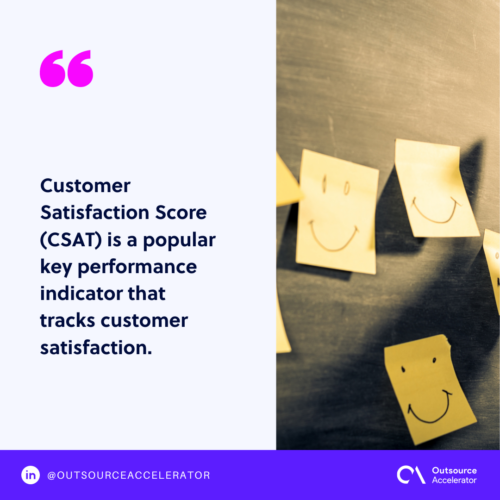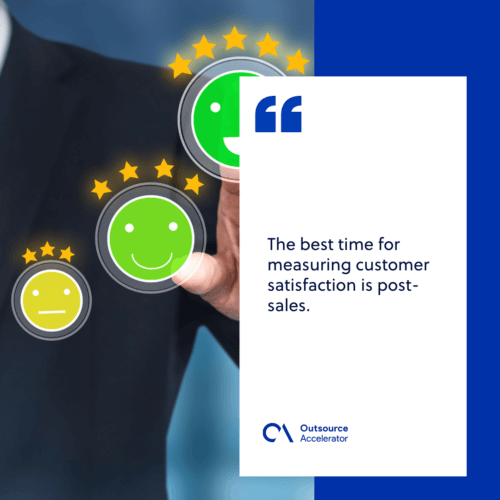Customer Satisfaction Rating (CSAT)
Definition
What is customer satisfaction (CSAT)?
Customer Satisfaction Score (CSAT) is a popular key performance indicator that measures customer satisfaction.
The process involves a survey question or a set of questions. Customers answer by indicating their level of satisfaction. The most popular scale is one to ten, with one being the least satisfied and ten as the most satisfying level.
The result gives a business the necessary output whether or not to improve customer service right then and there.
However, the possible ambiguity might be a disadvantage, especially if a customer is dissatisfied with the service.

Why is CSAT important?
CSAT scores allow companies to look into how their customer feels in each interaction with sales agents. CSAT provides business leaders with two important pieces of information:
- A detailed insight into customer success at every touchpoint of the journey
- Overall customer experience
Customer satisfaction scores enable businesses to determine the pain points in their service that impact the customer journey.
Addressing all these pain points and correcting them helps identify unhappy customers and turn them into happy customers, which increases the customer’s lifetime value over time.
Buyers are also more likely to become repeat customers — and eventually, become loyal clients — if they have experienced an excellent customer experience in a particular business.
Moreover, because CSAT is measured through doing a customer satisfaction survey, as well as gathering feedback and online reviews, sales agents can do a deep dive into their customer base.
This means that they now have access and the capacity to understand what their clients need and want from any business.
What can you measure with CSAT survey scores?
CSAT survey scores can provide valuable insights into various aspects of your business’s performance and customer satisfaction levels.
Here are some key metrics and areas you can measure using CSAT survey scores:
Overall customer satisfaction
CSAT survey scores provide a direct measure of customers’ satisfaction levels with your product, service, or interaction. This overarching metric reflects the general sentiment of your customer base.
Product or service performance
CSAT scores can help assess how well your products or services meet customer expectations.
By analyzing CSAT scores for specific products or services, you can identify areas for improvement or areas of strength.
Customer support effectiveness
CSAT scores for customer support interactions indicate how satisfied customers are with the assistance they received.
This metric helps evaluate the performance of your support team and the effectiveness of your support processes.
Transaction experience
CSAT scores can measure customer satisfaction with specific transactional experiences, such as online purchases, in-store visits, or service appointments.
Understanding transactional CSAT scores helps optimize the customer journey and streamline processes.
Feature satisfaction
For products or services with multiple features or functionalities, CSAT survey scores can assess satisfaction levels with individual features.
This information guides product development and feature prioritization efforts.
Example of a customer satisfaction survey
A customer satisfaction survey is designed to measure how satisfied customers is with a product, service, or experience.
Here’s an example of a CSAT survey:
Dear [Customer’s Name],
Thank you for choosing [Your Company]! We value your feedback and would like to know about your experience with our [product/service/event].
Please rate your overall satisfaction on a scale of 1 to 5:
- Very Dissatisfied
- Dissatisfied
- Neutral
- Satisfied
- Very Satisfied
Product/Service/Event: [Specify the product, service, or event]
- How satisfied are you with the quality of our [product/service/event]?[ ] 1 [ ] 2 [ ] 3 [ ] 4 [ ] 5
- Did the [product/service/event] meet your expectations?[ ] Yes [ ] No
- How likely are you to recommend our [product/service/event] to others?[ ] Not likely at all [ ] Not very likely [ ] Neutral [ ] Somewhat likely [ ] Very likely
- Please share any specific comments or suggestions you have about your experience:
[Open-ended text box]
Demographic Information (optional):
- Gender:[ ] Male [ ] Female [ ] Prefer not to say [ ] Other: _______
- Age group:[ ] 18-24 [ ] 25-34 [ ] 35-44 [ ] 45-54 [ ] 55-64 [ ] 65+
- How did you first hear about [Your Company]?
How to calculate customer satisfaction score?
Measuring CSAT is pretty straightforward.
To calculate customer satisfaction score, you have to add the positive responses together, divide them by the total number of responses collected, and multiply by 100.
The outcome will give you the overall percentage of customer satisfaction in your business.
For example, if 50 people took part in your customer survey and 30 of them gave positive feedback — your CSAT score would then be 60%.
See here:
(30 positive responses / 50 total responses = .60 x 100 = 60%)
This indicates that while the majority of your clients are satisfied with your service, you can still improve it to better serve your customers.
The best time for measuring customer satisfaction is post-sales.
These times are especially crucial for repeat and new customers as the experience is still fresh in their minds.

What is a good CSAT score?
Now that you have your customer satisfaction score, the next thing to do is determine whether it is good enough to guarantee excellent customer service.
Is your numerical score enough to gain new customers and improve customer retention rate across the overall customer lifecycle?
While every industry has different standards for CSAT scores, high customer satisfaction scores usually fall between 75% and 80%.
Reaching this customer satisfaction rate means that three out of every four buyers had a positive experience with your brand.
While most companies would love to see 100% satisfaction in their services, that is rarely the case.
Additionally, the pandemic has certainly affected a customer’s experience and happiness when purchasing a product or service.
Each buyer has his or her own opinions and standards.
Having customer conversations, hearing their responses, and gauging customer happiness regarding a product or service can help companies create new strategies that could improve customer satisfaction.
CSAT in outsourcing
Customer satisfaction score might be the simplest metric, but it’s a powerful tool for all businesses. It encompasses the whole customer journey and helps businesses determine the things that they should improve on to gain customer loyalty.
Measuring customer satisfaction is quick and easy. You add up all the ratings and divide the total score by the number of respondents. Most likely, you’ll get a percentage.
Get your customer satisfaction score a notch higher by outsourcing your customer service team. Check out Outsource Accelerator’s extensive list of outsourcing companies in the Philippines.

Strengthening customer loyalty with CSAT
Customer loyalty refers to buyers who always return to your brand for repeat business.
It is usually triggered by customer satisfaction, positive customer experiences, and the overall value of the goods or services a customer receives from a business.
A company’s CSAT score evaluates the services of different brands and determines if your company is able to retain customers instead of losing them to competitors.
It also brings customer insights and user feedback so that businesses can strengthen their services.
It could be hard for business owners or sales representatives to identify unhappy customers from satisfied customers.
CSAT surveys assist in detecting customer satisfaction at the earliest stage of the customer lifecycle.
They allow companies to amend poor customer service and improve it before experiencing the worst-case scenario — an increase in customer churn rate.
Remember, customer expectations for a possible repeat business rather than losing them to competing brands.
Trust is a critical part of any business relationship, but finding the right strategies to improve it — along with your customer satisfaction — can be challenging.
There is more than one side to the customer satisfaction equation. The key to improving customer satisfaction is a healthy balance between understanding and improving performance internally while doing the same with customers externally.
Tips to improve your CSAT scores
There are a couple of tricks that you can use to improve your CSAT score and ensure excellent customer interaction all the time. Here are some of them:
Request customer feedback
The easiest way to gauge your market’s reaction to your products or services is to ask them to rate their customer experience.
This can be done by handing out customer satisfaction surveys to post-calls or asking them for an online review.
A collected customer feedback will help you identify service issues and address them quickly so that you won’t lose your clients’ trust.
Meet customer expectations
Customers usually expect to gain whatever good things you have said about your business.
So, to keep them satisfied, it is important for your whole team to work hard to meet those expectations.
For example, if you say that your customer support call center is open 24 hours, then you have to put some of your staff on standby at all times for any inbound calls.
If you advertise a promo for a specific product, then you have to uphold it for every buyer.
Additionally, it is important to remain transparent with your consumers. From the time that they are still prospective buyers, you have to make sure that they already know what to expect from your brand and the policies that they will be agreeing with as paying customers.

Provide proactive customer service
If you want to boost customer satisfaction, you have to make sure first that you have a dedicated contact center for your clients. This contact must be personal, timely, and always pertinent to the user.
Reduce inbound calls in call centers as they increase agent effectiveness.
By offering customer service proactively, you can show the customer that good support does not only benefit the business.
CSAT vs. NPS vs. CES
CSAT is not the only key performance indicator that measures customer satisfaction.
Businesses also look into their net promoter score (NPS) and customer effort score (CES) to capture customer feedback and measure customer loyalty.
The net promoter score determines the likelihood of customers recommending your business to other consumers.
The higher your NPS score is, the bigger the chance there is for brand recognition.
NPS scores are usually measured using a one to ten rating system.
CES, meanwhile, measures customer sentiment on how well they have used your products or services.
The CES surveys aim to determine the ease or difficulty of customers deciding on purchasing your products.







 Independent
Independent




